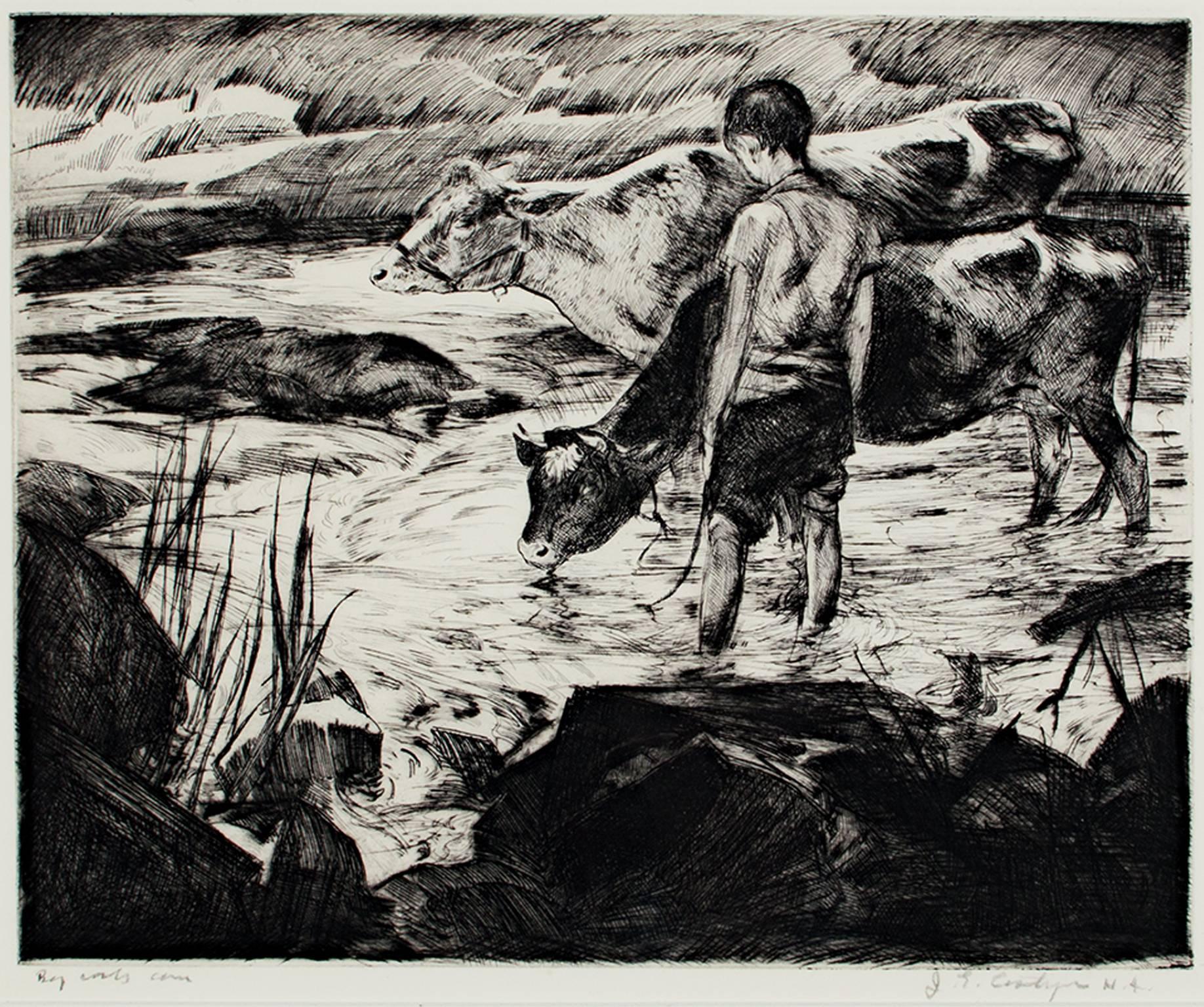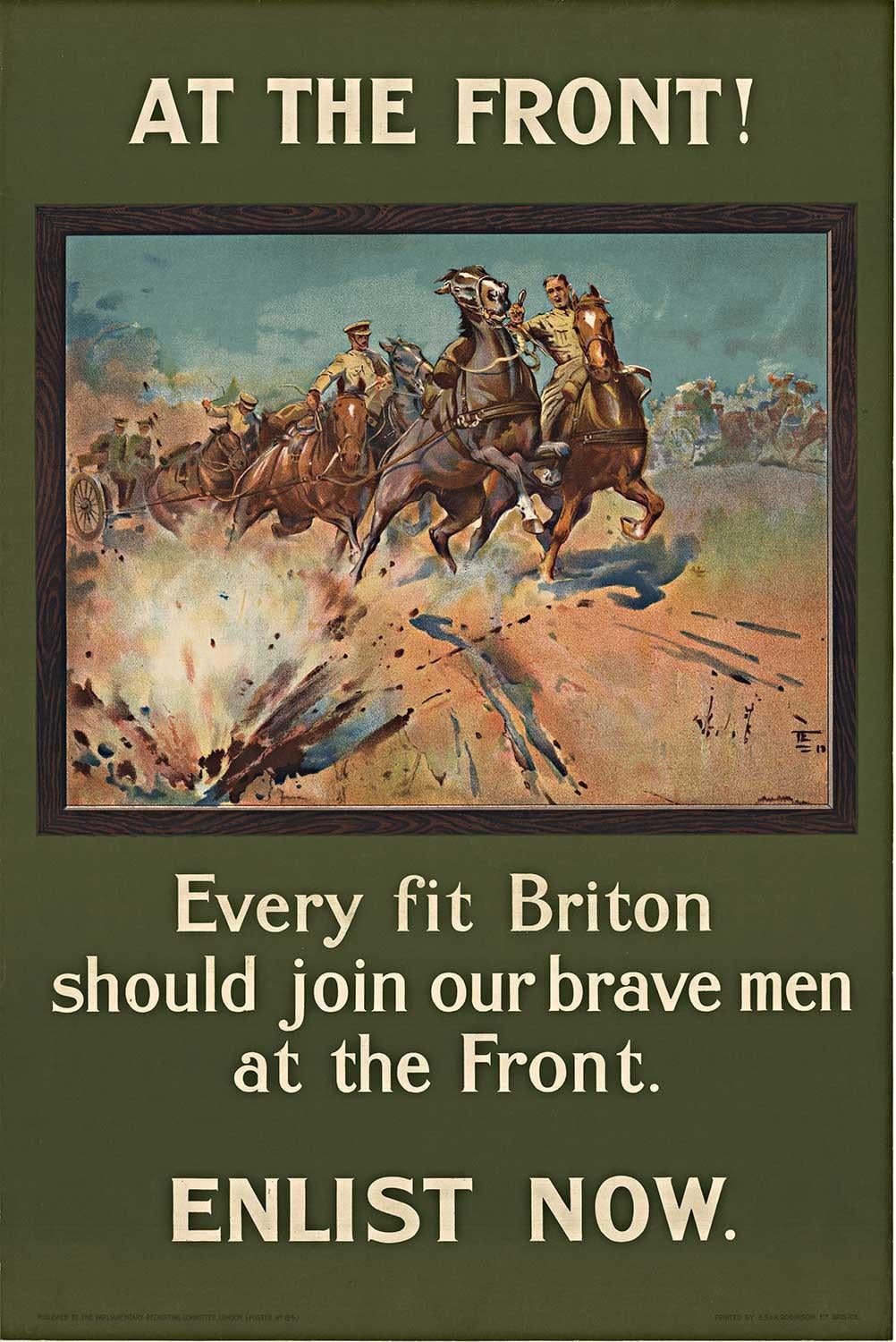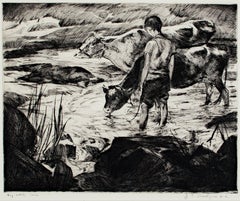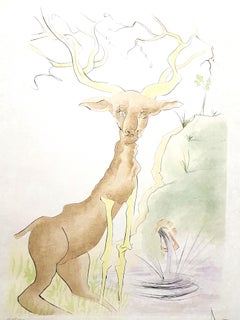Items Similar to A Burro Train, New Mexico
Want more images or videos?
Request additional images or videos from the seller
1 of 10
Peter MoranA Burro Train, New Mexico1880
1880
About the Item
This artwork titled "A Burro Train, New Mexico" 1880 is an original etching on Laid paper by noted British/American artist Peter Moran, 1841-1914. It is signed in the plate as issue. The plate mark (Image) size is 9.15 x 6.5 inches, framed size is 14.75 x 18.75 inches. It is framed in a wooden silver frame, with light grey matting. It is in excellent condition, especially considering the age. I like to mention that example of this particular etching is held in the following museums, including, The Toledo Museum Of Art, Toledo, The British Museum, London and The Smithsonian Museum Of Art, Washington D.C. It was also illustrated in American Art Review, volume #2 1881, page 163.
About the artist:
The younger brother of Thomas Moran, Peter Moran was a painter-etcher best known for his Romantic sensibility and landscape compositions incorporating animals. The Moran family immigrated to the United States from England in 1844, when Peter was three. He began his artistic career as an apprentice to a lithographic firm and eventually studied painting with his brothers Edward and Thomas. He was influenced by the animal paintings of Rosa Bonheur and Constant Troyon and visited England in 1863 to see those of Edwin Landseer.
Moran took up etching in 1874, using that medium to record genre scenes that he observed while traveling in New Mexico and Arizona in 1881 on an ethnographic expedition to study Pueblo Indian culture. He later returned to the Southwest in 1890 as an artist for the Bureau of Indian Affairs.
In 1882, Moran joined Henry R. Poore, an artist friend, on a visit to Taos Pueblo where the two were given a room and spent a week watching the activities associated with the harvest. Poore recounted the details of their travels in an article titled "A Harvest with the Taos Indians," published in 1883.
Peter Moran appears to have been the first American artist to make etchings of New Mexico subjects. Moran eventually gained a reputation in his day of "having been the first among the artists to recognize the picturesque qualities of the scenery of the southwest," according to a book published in 1883, and of capitalizing on "all the glaring sunlight, all the romance of wild life," in the "tablelands and in the cañons of New Mexico."
- Creator:Peter Moran (1841-1914, American)
- Creation Year:1880
- Dimensions:Height: 14.75 in (37.47 cm)Width: 18.75 in (47.63 cm)Depth: 0.7 in (1.78 cm)
- Medium:
- Movement & Style:
- Period:
- Condition:
- Gallery Location:San Francisco, CA
- Reference Number:Seller: pet/mor/bur/011stDibs: LU66639648652
About the Seller
5.0
Platinum Seller
Premium sellers with a 4.7+ rating and 24-hour response times
Established in 1999
1stDibs seller since 2017
781 sales on 1stDibs
Typical response time: 2 hours
- ShippingRetrieving quote...Shipping from: San Francisco, CA
- Return Policy
Authenticity Guarantee
In the unlikely event there’s an issue with an item’s authenticity, contact us within 1 year for a full refund. DetailsMoney-Back Guarantee
If your item is not as described, is damaged in transit, or does not arrive, contact us within 7 days for a full refund. Details24-Hour Cancellation
You have a 24-hour grace period in which to reconsider your purchase, with no questions asked.Vetted Professional Sellers
Our world-class sellers must adhere to strict standards for service and quality, maintaining the integrity of our listings.Price-Match Guarantee
If you find that a seller listed the same item for a lower price elsewhere, we’ll match it.Trusted Global Delivery
Our best-in-class carrier network provides specialized shipping options worldwide, including custom delivery.More From This Seller
View AllDancers
Located in San Francisco, CA
This artwork titled "Dancers" c.1990is a color offset lithograph by noted equine American artist Fred Stone, 1930-2018. It is hand signed in pencil by the a...
Category
Late 20th Century American Realist Animal Prints
Materials
Lithograph
Wildcat
Located in San Francisco, CA
This artwork "Wildcat" c.1990 is an offset lithograph by noted animals wildlife artist Jacquie Marie Vaux. It is hand signed and numbered from the edition of 750 in pencil by the art...
Category
Late 20th Century American Realist Animal Prints
Materials
Lithograph
Soaking Up
Located in San Francisco, CA
This artwork titled "Soaking Up" c.1970 is an original lithograph on Wove paper by noted western artist Tom (Thomas) Ryan, 1922-2011. It is hand signed, titled and numbered 68/100 in pencil by the artist. The artwork (image) size is 12.25 x 17.35 inches, sheet size is 17.5 x 21.65 inches. It is in excellent condition
About the artist:
Tom Ryan was born Jan. 12, 1922, in Springfield, Ill., to William Martin Ryan — whose family immigrated to Illinois from Ireland in the 1880s — and Sarah Helen Behrens, whose ancestry predates the Revolutionary War. They had nine children — six boys and three girls. He began drawing before he went to school.
"I was 4 years old and drawing airplanes, and an older brother was helping me," Ryan told the Reporter-Telegram in a 2002 interview at the Haley Library's going away party held in his honor. "Those were my first art lessons."
He did not decide to be an artist until after his service in World War II. While in the U.S. Navy during the war, he "made quite a bit of money" drawing portraits of his shipmates and other servicemen. After being discharged in 1945, he picked up a Life magazine that carried an article about N.C. Wyeth.
"I read the article, and I liked what I read, and I loved the pictures reproduced from his paintings in the article," Ryan said in 2002. "I decided then and there to be an artist."
Following his graduation from the American Academy of Art, an education made possible through the GI Bill, he returned to Springfield where he married Jacqueline "Jacquie" Harvey, daughter of a local doctor. She died in 1998.
The Ryans moved to New York City where he continued his studies at the Art Students League. During his second year at the Art Students League, he won a contest. His winning painting became the cover for Western writer Ernest Haycox's novel The Outlaw.
"Every month after that I also received an assignment from this publisher, and they would be Western novels," Ryan said in 2002. "So that's what I did for the next six or seven years. Then I started exhibiting at the Latendorf Gallery on Madison Avenue. What I sold mainly were the book covers. They would be published and I would get paid by the publisher, and I'd take them to the gallery, and I'd get paid again."
Ryan began making trips west in the late 1950s. He would stay three or four months painting, sketching and photographing scenes he'd need later. At that time, his works centered around historical events and places.
"I particularly liked to do some of the trail drive things that I did, like the old longhorns," Ryan said in 2002.
In the early 1960s, a work by Norman Rockwell and one by Ryan appeared in the same catalog. Rockwell, who was doing the Boy Scouts calendars for Brown and Bigelow, the premiere calendar publishing company in the United States, told the calendar company about Ryan.
"The art director gave me a call and asked if I'd like to do a contemporary cowboy...
Category
Late 20th Century American Realist Figurative Prints
Materials
Lithograph
Horsemen
By William Gropper
Located in San Francisco, CA
This artwork titled "The Horsemen" 1935, is an original lithograph on paper by noted American artist William Gropper, 1897-1977. It is hand signed in pencil by the artist. The artwork (image) size is 9.5 x 12.75 inches, framed size is 17.5 x 20.40 inches. Published by Associated American Artists, New York, printed by George Miller. Referenced and pictured in the artist catalogue raisonne by Steinberg, page 246 and Windisch and Cole, plate #602. Custom framed in a black metal frame, with off white matting. It is in excellent condition, the frame have very minor scratches.
An example of this particular artwork is held at the Metropolitan Museum of Art, New York. and at the Portland Museum, Portland.
About the artist:
William Gropper was born in New York City's Lower East Side in 1897. He was the first of six children to parents who earned small wages working in sweatshops. At the age of fourteen, Gropper left school to help support his family. While carrying bolts of cloth for his deliveries, Gropper began to draw on scraps of paper, sidewalks, and walls. A passerby saw some of these drawings and invited Gropper to attend a life-drawing class at the Ferrer School. He studied there for three years from 1912 to 1915, attending classes taught by Robert Henri and George Bellows. From 1915 to 1918 Gropper attended the New York School of Fine and Applied Art part-time on scholarship. Gropper also won a scholarship to the National Academy of Design, but remained as a student for only a short time; the rigid and systematic institution conflicted with Gropper's belief in the personal nature of art.
At the New York School of Fine and Applied Art, Gropper earned several prizes. One of these prizes was for his cartoons, which led him to be hired by the New York Tribune in 1917 to sketch for their features. A few years later through freelance work, his cartoons and drawings appeared in other newspapers and magazines, such as The Liberator, The New Masses, The New York Post, The New Yorker and Vanity Fair.
By the late 1920s Gropper was an established cartoonist and draughtsman. He sympathized with the labor movement and was a champion of peace and personal liberty. Gropper began to paint seriously, but privately, on these themes in 1921. Gropper's first exhibition of monotypes was held in 1921 at the Washington Square Book Shop in New York. At this time, he also began to do illustrations for books. Gropper took his first sketching trip in 1924 to the West with Morris Pass.
By 1930 Gropper began to receive recognition as a fine artist. In 1934, he received two mural commissions from the Schenley Corporation in New York City. In 1935, he was commissioned to paint a mural for the Hotel Taft in New York City. In 1936, Gropper received several public mural commissions: one was for the Freeport, Long Island Post Office, which was completed in 1938 and followed by another mural for the Northwestern Postal Station, Detroit, Michigan.
In his first gallery exhibition in 1936 at ACA Galleries, Gropper's work was so well received by critics, collectors, and artists that the following year he had two one-man exhibitions at ACA Galleries. In 1937, Gropper traveled west on a Guggenheim Fellowship and visited the Dust Bowl and the Hoover and Grand Coulee Dams, sketching studies for a series of paintings and a mural he painted for the Department of the Interior in Washington, DC. That same year he had paintings purchased by both the Metropolitan Museum of Art and the Museum of Modern Art.
Gropper exhibited at the 1939 New York World's Fair, Whitney Museum of American Art (1924-55), Art Institute of Chicago (1935-49), Carnegie International (1937-50), Pennsylvania Academy of the Fine Arts (1939-48), and National Academy of Design (1945-48). He was a founder of the Artists Equity Association and member of the National Institute of Arts and Letters.
From 1940 to 1945 William Gropper was preoccupied with anti-Nazi cartoons...
Category
Mid-20th Century American Realist Figurative Prints
Materials
Lithograph
Soaking Up
Located in San Francisco, CA
This artwork titled "Soaking Up" c.1970 is an original lithograph on paper by noted western artist Tom (Thomas) Ryan, 1922-2011. It is hand signed, titled and numbered 68/100 in penc...
Category
Late 20th Century American Realist Figurative Prints
Materials
Lithograph
Leopard
Located in San Francisco, CA
This artwork "leopard" c.1990 is an offset lithograph by noted animals wildlife artist Jacquie Marie Vaux. It is hand signed and numbered 366/750 in...
Category
Late 20th Century American Realist Animal Prints
Materials
Lithograph
You May Also Like
20th century drypoint etching figurative animal print black and white signed
By John Edward Costigan
Located in Milwaukee, WI
"Boy With Cows" is an original drypoint etching by John Edward Costigan. It depicts a young boy with three cows standing in a watering hole. The artist si...
Category
1930s American Realist Figurative Prints
Materials
Drypoint, Etching
Original "At The Front! Enlist Now" British vintage poster
By Lionel Edwards
Located in Spokane, WA
Origiinal WW1 poster: AT THE FRONT! Every fit Briton should join our brave men at the front. Enlist NOW. . Artist: Lionel Edwards.
Original, Mint, Linen-backed original World War 1 rare stone lithographic poster. At the front! Every fit Briton should join our brave men at the front. Enlist now / printed by E.S. & A. Robinson Ltd., Bristol. London: Parliamentary Recruiting Committee, [1915]. Poster showing cavalry in battle, with horses reacting to an explosion in the foreground.
Until March 2, 1916, when the Military Service Act introduced conscription, Great Britain’s World War I army was comprised entirely of volunteers. Many of the most famous wartime posters...
Category
1910s American Realist Figurative Prints
Materials
Lithograph
$1,198 Sale Price
20% Off
Meditation and Minou
By Will Barnet
Located in Buffalo, NY
Artist: Will Barnet, American (1911 - 2012)
Title: Meditation and Minou
Year: 1980
Medium: Lithograph and Serigraph on BFK Rives, signed and numbered in pencil
Edition: 40/150
Category
1970s American Realist Figurative Prints
Materials
Lithograph, Archival Paper
Salvador Dali - Le Cerf from Le Bestiaire de la Fontaine - Signed Engraving
By Salvador Dalí
Located in Collonge Bellerive, Geneve, CH
SALVADOR DALI
Le Cerf se voyant dans l'eau from Le Bestiaire de la Fontaine
1974
Hand signed by Dali
Edition: /250
The dimensions of the image are 22.8 x 15.7 inches on 31 x 23.2 in...
Category
1970s Surrealist Figurative Prints
Materials
Drypoint, Aquatint
The Matador.
By James McBey
Located in Storrs, CT
The Matador. 1911. Drypoint. Hardie 109. 6 7/8 x 10 7/8 (sheet 7 7/8 x 12). Edition 15. A few scattered foxing marks and slight mat line; otherwise fine o...
Category
1910s Modern Animal Prints
Materials
Drypoint, Etching
$1,200 Sale Price
27% Off
Night Time, Dieppe.
By Edmund Blampied
Located in Storrs, CT
Night Time, Dieppe. 1926-27. Drypoint. Appleby 123. 7 7/8 x 11/ Edition 100. A fine impression printed on cream laid paper with full margins. Signed in penc...
Category
1920s Modern Figurative Prints
Materials
Drypoint, Etching
$975 Sale Price
22% Off





